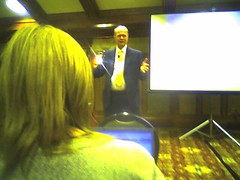Notes from David’s presentation: [Moblogged]
 Kids spend 90 minutes a day reading. They spend 4 hours a day using video. We spend many years teaching children to read. But do we teach them the grammar of images and motion pictures?
Kids spend 90 minutes a day reading. They spend 4 hours a day using video. We spend many years teaching children to read. But do we teach them the grammar of images and motion pictures?
Text addresses the rational mind. Pictures hit our emotions. Now a very good writer can stir our emotions. But it’s the combination of text (fact) and pictures (emotion) that is causing the silence we are experiencing right now, as Thornburg describes and shows us the 9th ward in New Orleans, five months after the disastrous flood that destroyed it.
He asks how many people have an iPod or iPod type device. Then he asked how many had more than 100 songs on their device. Nearly every hand is going up. How many have at least 500 songs? Again, nearly every hand. 1000 songs? Most hands. Then he pointed out that the average radio station has a 100 to 300 song playlist. We live in a world of choice. Choice means decisions, and decisions mean critical use of information.
A majority of textbooks are published in the UK? How might this impact on what history books say about the American Revolution — no reporting about the atrocities that were performed by British troops. I won’t go into detail. But the implication is that we should be careful about our children learning through a single window, a single point of view. It is critical that we make sure that students are learning from a variety of primary source information.
New Literacy
- Literacy,
- Numeracy,
- Mediacy
- Esthetics
- Mechanics
- Communication skills
Our challenges are:
- Storage
- Compression
- Finding content once you have it
A big part of the problem is the user interface. Have you ever downloaded something from the Internet, and then not been able to find it, and you then downloaded it again? That’s the single most damning thing you could say about the interface.
How do you find documents in a terabyte landscape? (A terabyte is 50,000 trees made into books.)
I’ve often suggested to teachers and librarians that they should be archiving students digital productions (music and video). I just saw what that archive might look like. Check out Safari Montage. Very cool.
[Zillow.com will map and also put the value of your house over it.]
